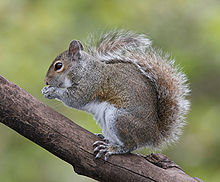

Europe's grey squirrels (Sciurus carolinensis) originated in North America, where they are known as eastern gray squirrels[1] (to differentiate from western gray squirrels). They eat large seeds, flowers, buds, fruits, fungi, some insects and occasionally bird eggs.[2]
They were first introduced into England, in a concerted way, in 1876,[3] and through rapidly growing population and further introductions they spread to the rest of Great Britain by the early to mid-20th century.[4] The eastern grey squirrel was introduced to Continental Europe in 1948 and has quickly taken advantage of Europe's food sources, habitats and lack of predators for grey squirrels.[1] Genetic studies have shown that human intervention-- released pets and intentional dispersal--may play a much larger role in the spread of grey squirrels than previously believed.[5]
The native squirrel in Europe is the red squirrel (Sciurus vulgaris). Both species have similar diets, use similar locations of the environment and have similar activity patterns; however, there is no evidence of noticeable aggression between the two species.[2] These eastern grey squirrels are considered an invasive species in Europe because of their presence contributing to the displacement of the red squirrels.
The invasion of the grey squirrel in the United Kingdom can be classified as a Disease Mediated Invasion (DMI).[6] More specifically, the invasion of the grey squirrels and displacement of the red squirrels can be described by "spillover DMI", which is defined as a non-native species bringing diseases with them into the new area that will infect the native species. Spillover is especially an issue of when the invading species is morphologically similar to the native one. This can have devastating effects.
- ^ a b Bertolino, S. & Piero, G. (2003) Spread and attempted eradication of the grey squirrel (Sciurus caolinensis) in Italy, and consequences for the red squirrel (Sciurus vulgaris) in Eurasia. Biological Conservation, 351-358
- ^ a b Sandro, B. (2008) Introduction of the American grey squirrel (Sciurus carolinensis) in Europe: a case study in biological invasion. Current Science, vol. 95, No. 7, 903-906.
- ^ Hickman, Leo (2012-09-05). "If you want red squirrels, you have to kill greys". The Guardian. London. Retrieved 2015-01-31.
- ^ Okubo, A.; Maini, P.K.; Williamson, M.H.; Murray, J.D. (1989-11-22). "On the Spatial Spread of the Grey Squirrel in Britain". Proceedings of the Royal Society B: Biological Sciences. 238 (1291): 113–125. Bibcode:1989RSPSB.238..113O. doi:10.1098/rspb.1989.0070. PMID 2575748. S2CID 27529608.
- ^ "Don't blame grey squirrels: Their British invasion had much more to do with us | Imperial News | Imperial College London". 26 January 2016.
- ^ Strauss, A., White, A., & Boots, M. (2012) Invading with biological weapons: the importance of disease-mediated invasions. Functional Ecology, 26, 1249-1261.
© MMXXIII Rich X Search. We shall prevail. All rights reserved. Rich X Search
